
views
Using a Water Filter

Pour the vodka though a standard water filter. The key ingredient in your filter that removes impurities from the vodka is generally a charcoal filter. This kind of filter removes oil and sugar, along with any other impurities, from the vodka that that make it taste less than delicious. Using a small funnel can help you pour your vodka into your filter's reservoir more easily, resulting in less liquor spilled.
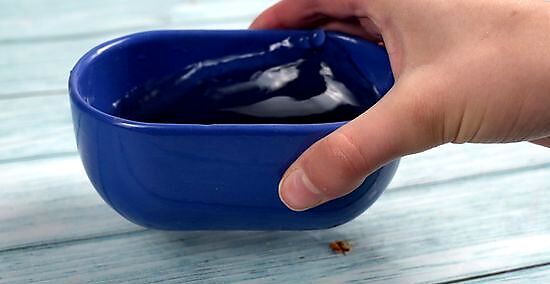
Agitate your vodka and keep it in a cool place. Give your vodka a firm swirl after completing each filtration cycle so that impurities are evenly distributed. This will create a consistent taste throughout your filtered batch and prepare it for the next round of filtration. You should also keep your vodka chilled, as colder temperatures will cause impurities to be easier for your filter to catch. While your vodka is dripping through the filter, you might place it in a freezer to help the filter catch impurities.
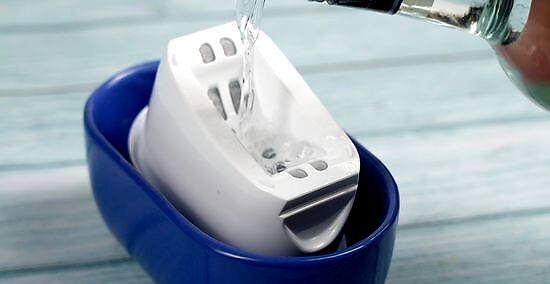
Filter your vodka 2-3 more times. Continue to regularly agitate your vodka and keep it in a cold place as you continue to filter. You'll want to use a clean container for the filtered vodka to collect into, and for best results, you may want to change your filter every few filtration cycles. As your filter strains impurities out of your vodka, its ability to continue to do so diminishes. While it's unlikely you'll need to change your filter after a single filtration, you should pay attention to your “change filter” indicator and swap in a new one when necessary. For filters without a “change filter” indicator, you may want to use a new filter every 2-3 filtration cycles for best results. Remember to swirl each completely filtered batch of vodka to improve its consistency.

Allow your filtered vodka to stand briefly. The filtration process causes the composition of the vodka to become disturbed. You'll want to give your recently filtered vodka some rest time (15-30 minutes should do the trick) before you then use it for drinking.
Filtering with Activated Charcoal
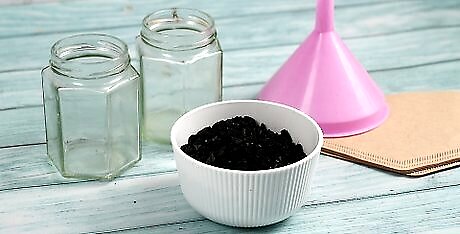
Gather your filtration materials. The key to this filtration technique is food-safe activated carbon, which can be bought at your local pet supply store. Activated carbon is a substance created to have holes in it smaller than the eye can see, making it ideal for filtering out fine impurities from a substance. You'll want at least 3 cups (1,020 g) of this for filtering. It should be relatively cheap to purchase from your local pet store, or you can buy bags in bulk from online retailers for even less. In addition to your activated carbon, you'll also need: Cheap vodka Coffee filters Colander 2 bottles/containers (larger than the amount of vodka purchased) Funnel Strainer/colander
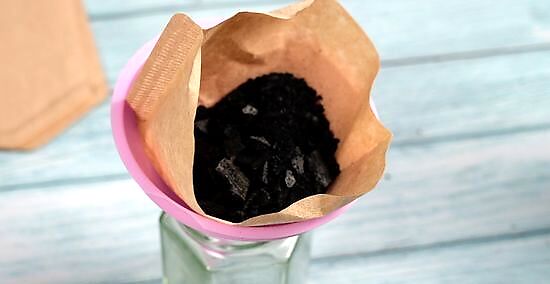
Prepare your activated carbon. Straight from the bag, your activated carbon will have some dust remaining on it from processing and handling. You don't want this residue getting into your vodka, so you should remove it from the carbon first by running your carbon under water while in a colander or strainer. Then you should: Place your activated carbon in a coffee filter. Cone shaped filters that will roughly match the shape of your funnel will make the filtration process easier, but standard coffee filters will work as well. Put about 2 inches (5 cm) of food-safe activated charcoal into your filter, and then place the filter inside your funnel.
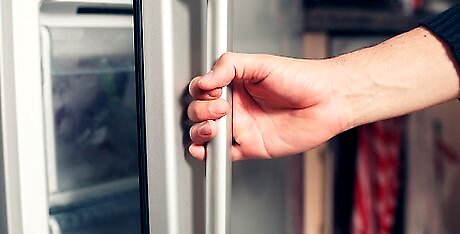
Chill your vodka and prepare a cold place for filtration. The colder your vodka is, the more easily the impurities will be soaked up by your carbon activated filter. You may want to chill your vodka in your freezer beforehand. For best results, you might consider clearing a space in your freezer so the vodka can filter in the cold.
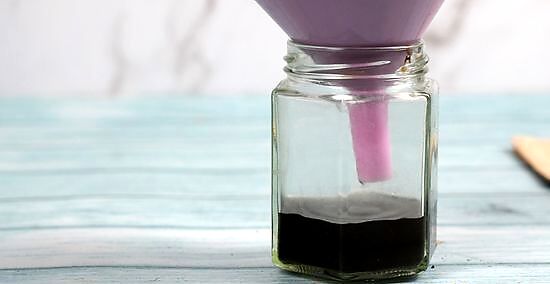
Drip filter your vodka into your container. Place your funnel firmly into the mouth of your container so that it is stable and will not fall over. Then pour vodka into your funnel until it is ¾ of the way full, though you'll want to keep the level of your vodka from going over the top line of your filter. If your vodka rises above the filter, there's a chance that it will trickle between the filter and funnel without receiving the purifying effects of the activated carbon. It may take a considerable amount of time for your vodka to drip filter through the carbon into your container.
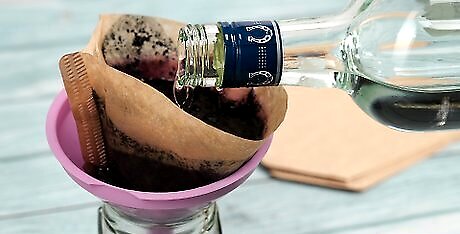
Prepare for round 2 of filtration. Filter your cheap vodka until none remains. When the level of your vodka begins to diminish in your funnel, you should add more to continue the filtration process. When finished the first filtered batch: Move your funnel with its filter and activated carbon securely into your second container to prepare for round 2 of filtration. Run your filtered batch through your carbon several times. The more times you pass your vodka through your activated carbon, the more impurities the carbon will soak up from it. Since fresh activated carbon filters at a better rate, after your second or third filtration cycle, you may want to change your coffee filter and activated carbon. Don't forget to rinse your fresh activated carbon to remove any silt or dust from it before using it for filtration. You should aim to keep your vodka exposed to the activated carbon for a minimum of 5 minutes to ensure the best results.
Polishing Vodka with Activated Carbon
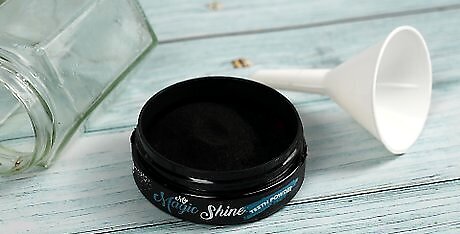
Gather vodka polishing materials. The main ingredient in liquor polishing is activated carbon, though adding your carbon to a full container of vodka may cause your container to overflow. You'll also have to strain the carbon out at some point, so you'll need: Food-safe activated carbon (3-5 cups (1,020-1,700 g) depending on the amount of liquor being polished) Container (freezer safe) Funnel Strainer/colander
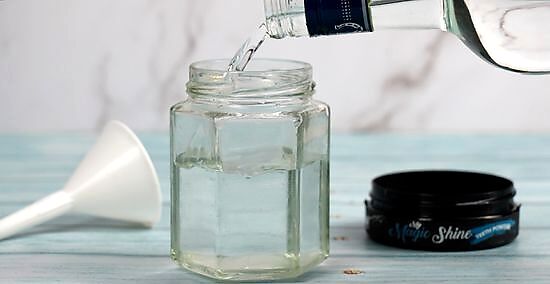
Pour your vodka into your container. You'll want a container that is larger than your amount of vodka, otherwise, when you add your carbon, you might lose some vodka to overflow. Place your funnel in the container, and pour your vodka from its original vessel into the container.
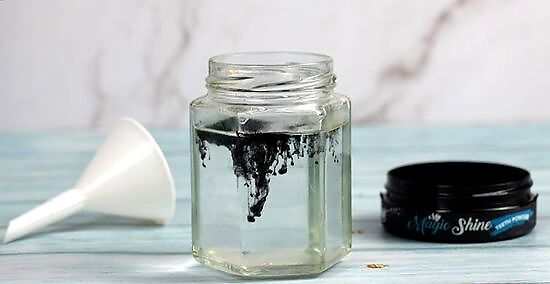
Add activated carbon straight to your vodka. Impurities in alcohol, like aldehydes, amino acids, and oils are likely the culprits making your cheap vodka taste foul. Polishing alcohol is the process of soaking it for a length of time in activated carbon to remove these impurities. Rinse your activated carbon in a colander/strainer under cold water to remove any dust that may have formed on it during the packaging and handling process. Add 1 cup (340 g) of food-safe activated carbon per 1 gallon (3.8 L) of vodka.

Allow the vodka to soak for 7-30 days. At minimum, you should allow your vodka to soak in the activated carbon you've added for a week. For even better results, you can allow the vodka to soak for a month, though after a few months you'll reach the carbon's limit and see little change in quality. Shake the vodka in its container for a few minutes every day to ensure the consistently filtration throughout the mixture. Keep your vodka in a cold location, like your freezer, to make the impurities in it easier for the activated carbon to absorb.
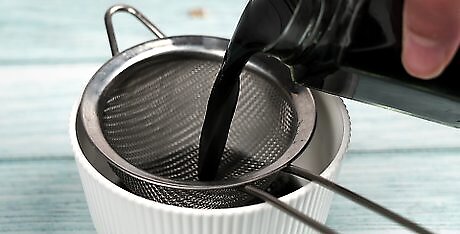
Strain your carbon from your vodka. A regular kitchen strainer should be sufficient to catch your activated carbon while letting the vodka drain through into a container. You may want to nest your strainer into your funnel so the vodka flows directly down the nozzle of the funnel and into a container, preventing lost liquor.
Disguising the Cheap Vodka Taste
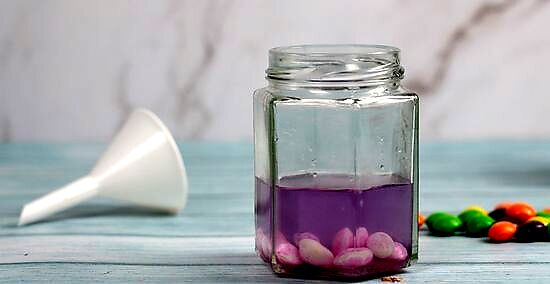
Infuse your cheap vodka with other flavors. By adding a new flavor to your vodka you can mask its harsh, cheap quality. This can be done through a process called infusion, where your cheap vodka takes on flavors from other ingredients, improving its taste. Some ideas that you might use to improve your vodka include: Make chocolate vodka – the sweetness of chocolate will cut the sharp, biting taste of your cheap vodka. Make Skittles vodka – sugar is often added to vodka to mask its burn. The sweetness of Skittles will mellow your cheap vodka's harshness. Try toffee vodka – combine vodka with toffee and let it sit for 24 hours for another sweet option. Infuse the vodka – there are many fruits, berry, and herb infusions you can add to your vodka. Choose your favorite to create a better tasting vodka!
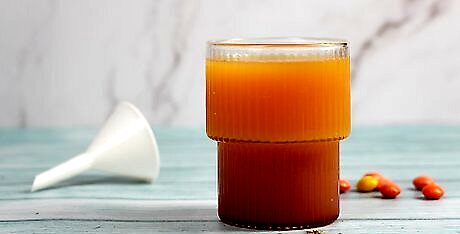
Make cocktails with your cheap vodka. Adding certain mixers to cheap vodka can cut its burn or hide its low quality flavor. Common mixers include sour mix, pineapple juice, orange juice, lemonade, and cola. The ratios you use for different cocktail recipes will vary, but generally you should follow the spirits:liqueur:mixer ratio of 3 parts to 2 parts to 1 part (3:2:1) for more liquor forward drinks, or 2 parts to 1 part to 1 part (2:1:1) for less strong cocktails.
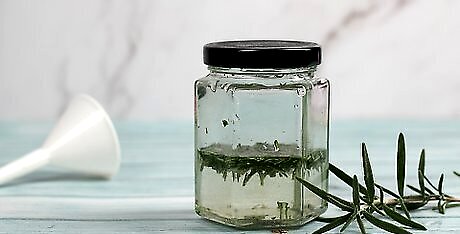
Cook with your cheap vodka. When you cook with vodka, most of the alcohol gets cooked off in the process, which disguises its poor flavor. This is why chefs prefer using lower quality wine when cooking. There are many recipes you could use your cheap vodka to make, including: Vodka sauce for pasta Seafood cooked in lemon and vodka Drunken shrimp Sunshine bitters Herbal tinctures



















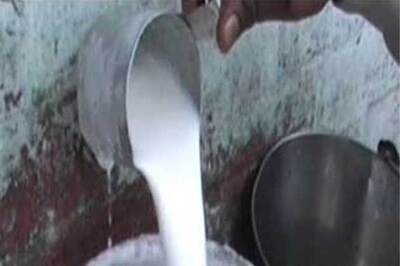
Comments
0 comment